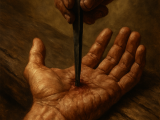“Roots and Wings: Embracing Faith Beyond Heritage”


In the tapestry of faith, each thread represents a journey, a heritage, and a story. For many, faith is a legacy, inherited like a cherished family heirloom. But what happens when the call of the Spirit leads us beyond the familiar boundaries of our inherited beliefs? This exploration is not just about leaving behind what we have known; it’s about embracing a faith that is both ancient and new, deeply rooted yet freely given. It’s about finding roots in the fertile soil of scripture and spreading wings in the boundless sky of divine revelation.
The Call to Abraham: A Journey of Faith
The journey of faith beyond one’s heritage is beautifully encapsulated in the call of Abraham. Genesis 12:1 (NKJV) says, “Now the Lord had said to Abram: ‘Get out of your country, From your family And from your father’s house, To a land that I will show you.’” Abraham’s call was to leave his country, his people, and his father’s household for a land that God would reveal. This act of faith—leaving the familiar for the unknown—marks the beginning of a spiritual lineage that values divine calling over cultural or familial heritage.
Ruth: Embracing a New Identity in Faith
Ruth, a Moabite, provides a profound example of embracing a new faith identity beyond her cultural and religious heritage. Her declaration to Naomi in Ruth 1:16 (NKJV), “Your people shall be my people, and your God, my God,” speaks volumes about the transformative power of faith. Ruth’s story is a testament to the fact that our commitment to God can lead us to adopt a new identity, one that transcends bloodlines and birthrights.
The Prodigal Son: Returning to the Father
In the parable of the Prodigal Son (Luke 15:11-32), we see a different kind of journey—one that leads back to the Father after a period of estrangement. This story is a powerful reminder that our heritage, while significant, does not define our relationship with God. The Father’s love and forgiveness are available to all, regardless of our past or the distance we’ve wandered.
Paul: A Heritage Transformed for God’s Glory
Paul the Apostle, originally Saul of Tarsus, is another compelling example of how one’s heritage can be transformed for God’s glory. Once a persecutor of Christians, Paul’s encounter with Christ on the road to Damascus changed the course of his life and mission. In Philippians 3:7-8 (NKJV), Paul says, “But what things were gain to me, these I have counted loss for Christ. Yet indeed I also count all things loss for the excellence of the knowledge of Christ Jesus my Lord.” Paul’s story encourages us to look beyond our ancestral faith and cultural identities, emphasizing a relationship with Christ as the true foundation of our identity.
Peter and Cornelius: Crossing Cultural Divides
The story of Peter and Cornelius in Acts 10 is a landmark event in the early church, highlighting the crossing of cultural and religious divides. Peter, a Jew, is instructed by God to visit Cornelius, a Gentile, breaking longstanding traditions and prejudices. Acts 10:34-35 (NKJV) records Peter’s realization: “In truth I perceive that God shows no partiality. But in every nation whoever fears Him and works righteousness is accepted by Him.” This passage underscores the inclusivity of God’s kingdom, inviting us to embrace faith beyond the limitations of heritage.
Embracing a Faith Beyond Heritage
The call to embrace a faith beyond our heritage is not a rejection of where we come from but an invitation to a deeper, more profound identity in God. It challenges us to consider our spiritual lineage through faith in Yeshua, not just our earthly lineage. Galatians 3:28-29 (NKJV) encapsulates this beautifully: “There is neither Jew nor Greek, there is neither slave nor free, there is neither male nor female; for you are all one in Christ Jesus. And if you are Christ’s, then you are Abraham’s seed, and heirs according to the promise.”
Conclusion: A Tapestry of Faith
Our journey of faith may lead us beyond the familiar landscapes of our heritage, but it does not leave us rootless. Instead, it grafts us into a rich tapestry of believers, woven through centuries of faith, sacrifice, and love. In this divine tapestry, every thread is vital, every color vibrant, and every pattern is part of a larger design crafted by the Master Weaver. As we embrace our faith beyond heritage, let us remember that we are part of something greater—a family of believers united not by blood, but by the Spirit of the living God.










